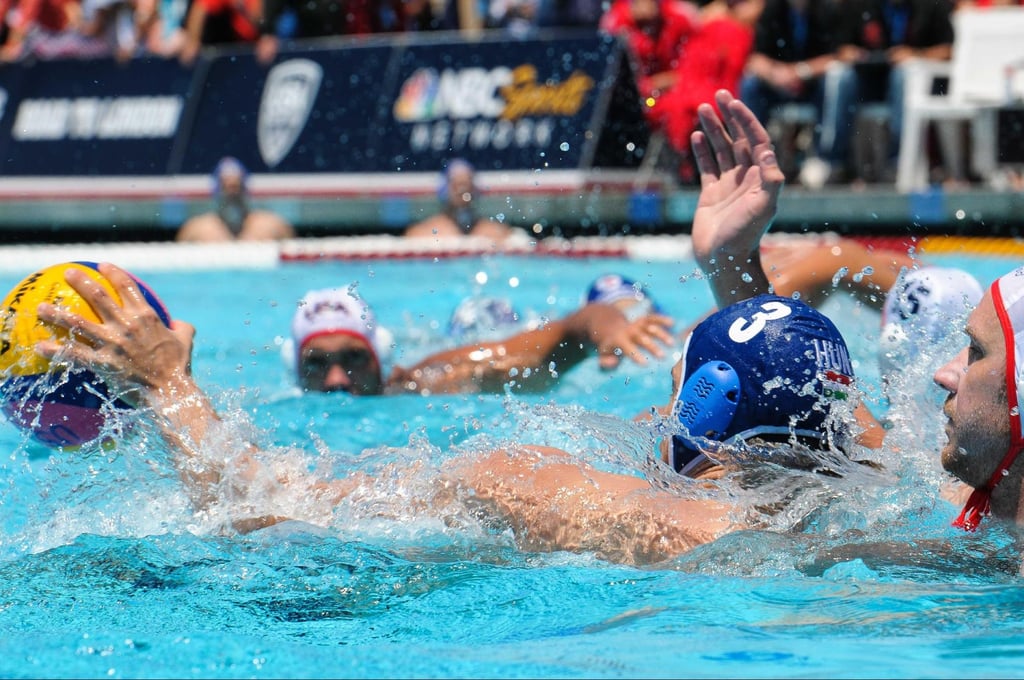Four Steps to Building a Dominant Water Polo Strength Program

Hard work in the gym results in better performance in the pool. Water polo-specific dryland training programs designed for each player’s position, their strengths and weaknesses, and the team’s competition calendar are paying off big time in the pool. Coaches can see the difference in terms of wins and losses. They are also seeing a reduction in injuries and an ability of their players to go hard all season long. Here’s a four-step guide on how to build a water polo-specific dryland program:
Step 1. Competition calendar.
Long before the first game begins, water polo players should be training. In the off-season athletes should start slow and build their foundation of flexibility and mobility by doing as many movements as possible with as little load as possible. Exercises should concentrate on increasing range of motion and work in multiple planes of the body. As the athlete builds a base, they should decrease number of exercises, decrease volume of repetitions, and increase weight. During this stage it is important for coaches to test, calibrate, and get the athletes ready for preseason. Water polo coaches need to balance the demands of the pool with the demands of dryland training.
In preseason, coaches should start to incorporate water polo-specific work in the pool. This means assigning position-specific drills and exercises calibrated to meet their unique needs. In the weight room that means attackers are doing more upper-body work and speed work. Two-meter attackers and defenders are doing solid leg base work and upper body strength work for their respective positions. On the other hand, goalies need to work on reaction drills and hip mobility and stability.
Once the season begins, it's all about maintenance. Maintenance doesn’t mean shutting down. It means keeping the athlete sharp, fresh, and ready for every game. Consequently, volume in the weight room decreases while coaches work on specific exercises for each position and athlete.
Additionally, the competition calendar is important. Strength coaches should balance games athletes can train through or games where they need to peak. For example, if a coach knows that games 3 and 8 can be powered through, and games 4 and 9 require their team to be fresh and playing at their peak, they may assign a difficult workout before games 3 and 8 and then taper the workout before games 4 and 9. Playing multiple games in a week require modification to the training schedule and a focus on recovery and regeneration.
Step 2: Functional output
The key to designing a solid dryland strength and conditioning program means taking into account functional output. An athlete's position and role they play on the team may require different needs for speed, power, and endurance. That means they need dryland programs customized for them. Attackers should work on upper-body strength, shoulder flexibility, and thoracic rotation for wrestling and shooting. Centers, both offensive and defensive, tend to be bigger athletes and need workouts that develop lower-body power for endurance and upper-body strength to push opponents around. Goalies are in a category of their own. They require good hip capsule and groin flexibility to set their base in the cage. To learn which dryland exercises improve goalie skills check out this article.
Step 3: Individualization
The starting point of any individual dryland strength and conditioning program begins with assessment and diagnosis. Since flexibility, mobility, stability, and strength work together, dryland programs should be designed to build on a player's strengths and obliterate their weaknesses. In water polo, that means examining the athletes’ hip capsule mobility, thoracic rotation and extension. In addition, a player's age and training experience needs to be considered when designing a individualized dryland program.
According to Olympic gold medalist, Jessica Steffens, “BridgeAthletic provides me with elite water polo-specific training that I can do anywhere and at any time. The workout experience is extremely engaging. I love the built-in level of competition that encourages me to work harder to beat my personal bests. Bridge water polo training emphasizes flexibility and core strength, which is key for me as an elite athlete.”
Step 4: Daily workout design
Coaches must also consider specificity of workout design in terms of personalizing warm up, preparation, main sets, and recovery.
Warm Ups
To get the most from athletes in the limited time they spend in the gym, warm ups should raise the core body temperature. Movements should be assigned based on the initial assessment as well as ones that prepare athletes for the upcoming workout.
Movement Preparation
After the body is warmed up, athletes should work on multi-planar and multi-joint movements. For example, bear crawl and inchworm exercises are particularly well-suited to water polo-specific workouts.
Main Sets
The core of the dryland workout should have exercises designed to build strength, speed, and power. The main sets and intensity will be determined by players’ positions and the team's competition calendar.
Recovery
Water polo-specific recovery exercises can reduce soreness and help prevent injury. Taking the time to properly is important for athletes to bounce back from training sessions and be ready for the next day.
Recap
These four steps are key to designing an effective water polo dryland training program. Enhancing strength and conditioning allows players to take their game to the next level. Check out this article on defensive-specific water polo exercises.
About the Author

Nick Folker is the Co-Founder and Director of Elite Performance at BridgeAthletic. Nick’s roster of athletes includes 35 Olympians winning 22 Olympic Medals, 7 team NCAA Championships and over 170 individual and relay NCAA championships.
Related Posts

The Best Bench Press Variation You’re...
This post is part of our Coaches Corner series with Taylor Rimmer. Taylor is NSCA-CPT, StrongFirst...

Does Powerlifting Harm Heart Health?
A recent study has discovered that a 12-week supervised strength training program (SSTP) may result...
-1.png)
Barefoot Running: Is It For You? |...
Run Free: Consider Less Cushion
Updated October 2020:
With more athletes looking for ways to...


